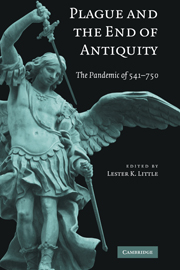Preface
Published online by Cambridge University Press: 05 June 2012
Summary
Plague helped carry out Antiquity and usher in the Middle Ages. Eight centuries before the Black Death did its part to carry out the Middle Ages and usher in the Renaissance, a similar pandemic of plague engulfed the lands surrounding the Mediterranean Sea and eventually extended as far east as Persia and as far north as the British Isles. Its sporadic appearances persisted from 541 to 750, the same period that witnessed the distinctive shaping of the Byzantine Empire, a new prominence of monasticism and of the Roman papacy, the gradual Christianizing of the Celtic and Germanic peoples, the beginnings of Islam, the rapid accumulation of the Arabic Empire, the ascent of the Carolingian dynasty in Frankish Gaul, and, not coincidentally, the beginnings of a positive work ethic in the Latin West.
Twelve specialists have here combined history, archaeology, epidemiology, and molecular biology to produce a comprehensive account of the pandemic's origins, spread, and mortality, as well as its economic, social, political, and religious effects. The historians' sources are written in Arabic, Syriac, Greek, Latin, and Old Irish. The archaeologists' finds include burial pits, abandoned villages, and aborted building projects. The epidemiologists use the written sources to track the disease's means and speed of transmission, the mix of vulnerability and resistance it encountered, and the patterns of its comings and goings.
- Type
- Chapter
- Information
- Plague and the End of AntiquityThe Pandemic of 541–750, pp. xi - xvPublisher: Cambridge University PressPrint publication year: 2006

